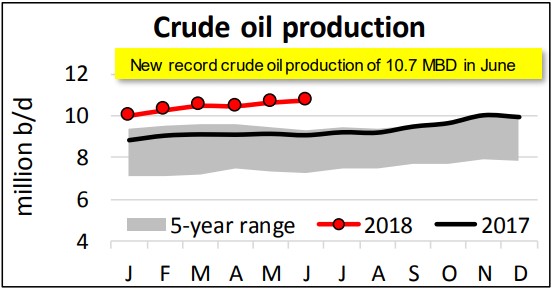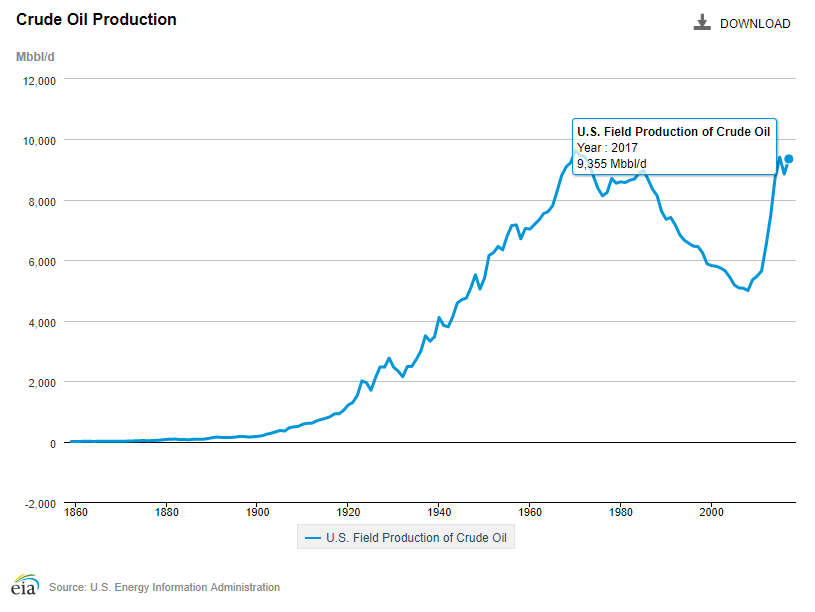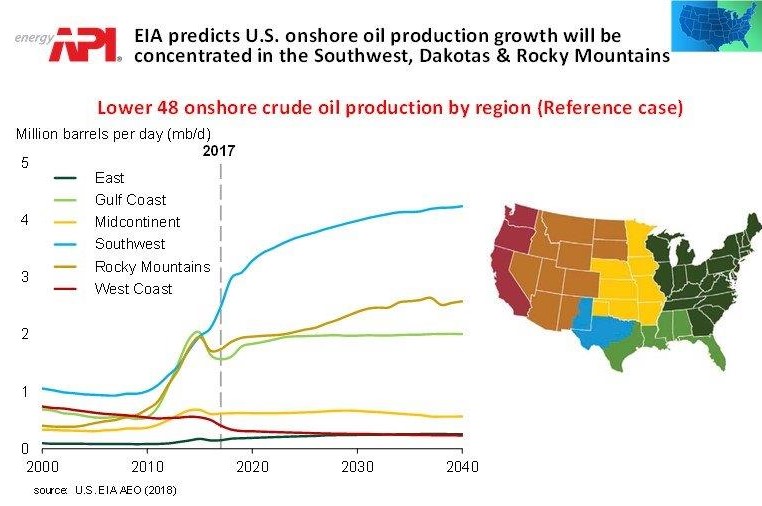Think: U.S. Oil, Increased Access to Boost Global Supply
Mark Green
Posted July 20, 2018
Big news in the latest API Monthly Statistical Report: U.S. crude oil production rose to an all-time record of 10.7 million barrels per day (mbd) in June – the largest monthly output, ever. Here’s a chart from the MSR:

Below, the U.S. Energy Information Administration’s chart showing U.S. oil production since the era of Col. Edwin Drake, with annual output peaking at 9.637 mbd in 1970:

Certainly, June production suggests total 2018 output could very well top that, and that we are on track to meet or exceed EIA’s Reference Case projections, below:

According to the MSR, June domestic crude production increased more than 100,000 barrels per day over May, and the total was 1.6 million barrels per day more than June a year ago. But let’s go back to that top-line number – 10.7 million barrels per day – and comprehend what it means:
Economic growth and jobs – but also our country’s energy security, supporting the promise of present and future prosperity and opportunity. That’s the gift of the American energy renaissance that, well, keeps on giving. API Chief Economist Dean Foreman:
“Record production of U.S. crude oil and natural gas liquids last month highlighted the strength of our nation’s energy renaissance. U.S. oil production has supplied all of the growth in global oil demand so far this year and helped compensate for production losses in some OPEC nations. With continued increases in drilling activity, the U.S. is poised for further production increases in natural gas and oil.”
All of the above support an argument that – to ensure an adequate global supply of crude oil upon which the U.S. and global economies rely – we should look to sustain and grow domestic natural gas and oil production.
One of the greatest benefits of the U.S. energy renaissance has been reducing our reliance on crude oil imports. Before the advent of advanced hydraulic fracturing and modern horizontal drilling – creating access to vast natural gas and oil reserves in shale and other tight-rock formations – the United States was increasingly dependent on imported oil. And too often, subject to one global supply disruption after another.
Today, the United States has increasing control over its energy present and future, thanks to domestic energy abundance, superior industry technology and innovation. As a result, should global markets tighten, it should encourage us to double down on domestic energy as a first strategy.
That means sound energy policies that support safe and responsible production: increased access to offshore and onshore reserves, smart regulation that encourages safety without needlessly hampering progress and more infrastructure. It means avoiding policy decisions that work against American energy, consumers and the economy, such as the new tariffs and quotas on imported steel. Foreman:
“Unfortunately, increasing tariffs on steel and other components that are vital to our industry’s infrastructure and operations have emerged as a key challenge. For the energy renaissance to continue, the U.S. natural gas and oil industry critically needs policies that advance energy infrastructure around the country as well as the access of U.S. energy to global markets.”
Increased benefits from domestic energy – for consumers, manufacturing, the broader economy and all of our futures – is within our grasp. That’s the big headline that goes with June’s record-setting crude oil production number.
About The Author
Mark Green joined API after a career in newspaper journalism, including 16 years as national editorial writer for The Oklahoman in the paper’s Washington bureau. Previously, Mark was a reporter, copy editor and sports editor at an assortment of newspapers. He earned his journalism degree from the University of Oklahoma and master’s in journalism and public affairs from American University. He and his wife Pamela have two grown children and six grandchildren.


